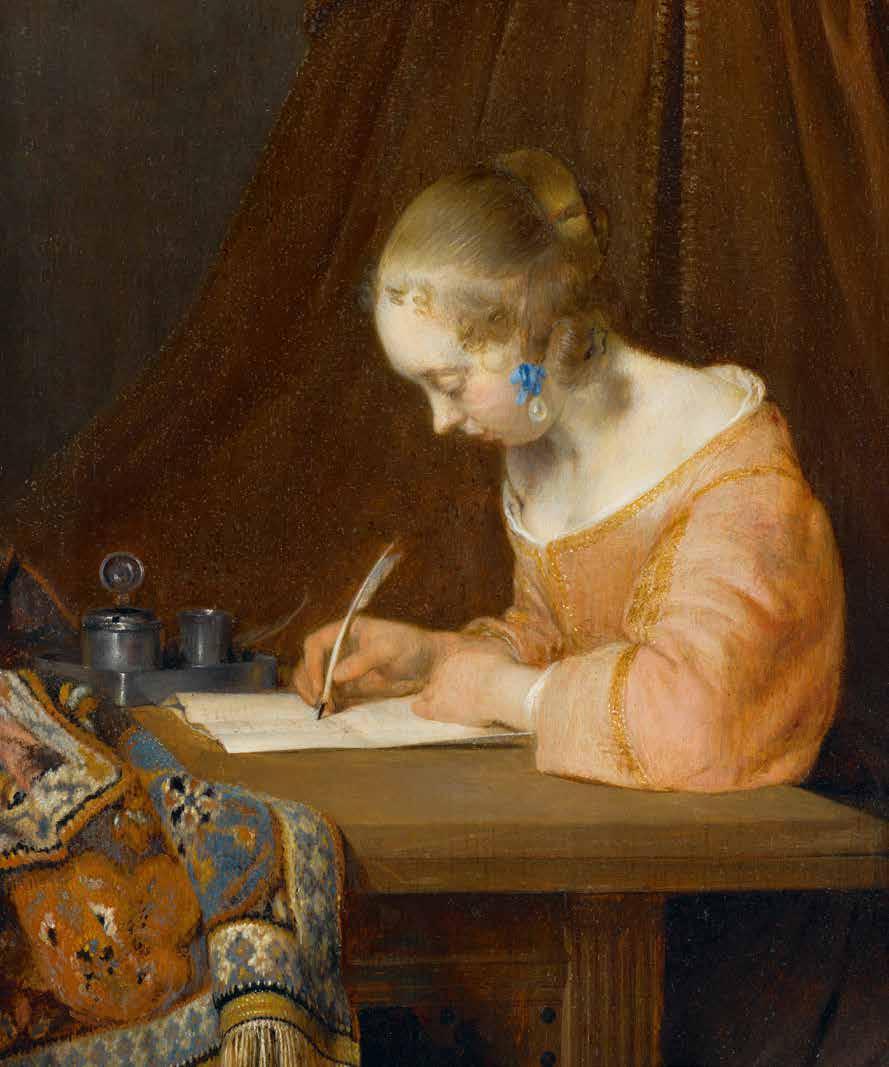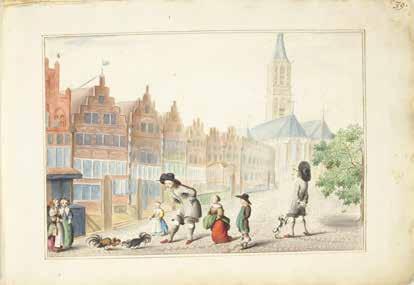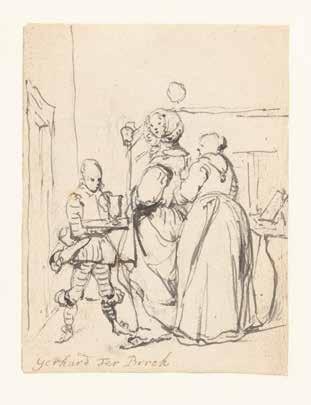




Marjorie E. Wieseman
Michael Klomp and Geertje Havers
Chourouk Hriech
Ilona van Tuinen
Foreword
Family Tree
von Bormann, Germa Greving, Coby Zandbergen
At Home with Ter Borch: A Look Inside an Artist Family
Marjorie E. Wieseman
Homes and Graves
Michael Klomp and Geertje Havers
What Gerard ter Borch’s paintings of interiors can tell us about the outside world...
Chourouk Hriech
‘Draw plenty’: Drawing Practices and Techniques in the Ter Borch Family
Ilona van Tuinen
List of Exhibited Objects
Image Credits and Lenders
Gerard ter Borch x Maria van Benthem
Gerard Berend
Jan
JAN TER BORCH (active 1624-1646)
Berend
Harmen ter Borch x Catharina Colen (1550-1634) (1557-1611)
Anna

Gerard ter Borch the Elder
Maria Johan
GERARD TER BORCH THE ELDER (Zwolle 1582/3-April 1662 Zwolle)
GERARD TER BORCH THE ELDER (Zwolle 1582/3-April 1662 Zwolle)
X 1613 X 1621 X 1628
Anna Bufkens (Antwerp 1587–c. 1621 Zwolle)
GERARD TER BORCH THE YOUNGER (Zwolle December 1617-December 1681 Deventer)
Jannechien (died after 1621)
Geesken van Voerst (Deventer 1599 - in or before 1628 Zwolle)
ANNA (Zwolle 1622-1679 Haarlem)
Sara (Zwolle 1624-1680 Haarlem)
Wiesken Matthijs (Deventer 1607-1683 Zwolle)
Mattheij (Zwolle 1629, died young)
GESINA (Zwolle November 1631-April 1690 Zwolle)
Cathrina (Zwolle died before 1633)
Cathrina (Zwolle 1633-?)
Catharina (Zwolle October 1634- before October 1704 Zwolle)
Aleida (Zwolle July 1636-after 1661 Zwolle)
HARMEN (Zwolle October 1638- c. September 1677 Zwolle)



Sijbrandt Schellinger
X 1668
Hillegonda (Curaçao 1674-1750 Zwolle)
Jenneken (Zwolle 1640-August 1675 Curaçao)
MOSES (Zwolle 1645-12 July 1667 Harwich, England)


3
HARMEN TER BORCH
Seated Child and a Child playing the Violin , 1650. Black chalk, 107 x 160 mm. Rijksmuseum, Amsterdam


Fig. 5
GESINA TER BORCH
Interior of an Inn with Two Dead People and a Drinker , c. 1658 ( Poetry Album , fol. 83 recto). Black ink, watercolour, heightened with silver, 313 x 240 mm. Rijksmuseum, Amsterdam
that convey movement, spontaneity, and a playful humour (cats. H4, H5, H8, H9). The artistic achievements of Moses, the youngest Ter Borch child, could probably have rivalled those of Gerard the Younger, had he not died in battle at the tragically young age of twenty-two. As a teen, Moses made self-portraits that bear an uncanny resemblance to Rembrandt’s similarly unsparing explorations of physiognomy and expression (cat. M11, fig. 6).7 Moses made tender portraits of family members (cats. M4, M5) and in the early 1660s, perhaps during his brief service as a volunteer with the Dutch fleet, a series of hauntingly individualised studies of young men and boys in military dress (cats. M13–M17).
Fig. 4
GESINA TER BORCH
Child playing the Violin , 1650 ( Materi-Boeck , fol. 17 recto).
Pen and ink, watercolour, 155 x 211 mm. Rijksmuseum, Amsterdam
The instruction Gerard the Elder provided his children incorporated many of the elements of traditional academic education, in which students acquired the skills and techniques necessary for successful artistic practice in a specific sequence. Surviving drawings, many of which are dated, suggest that he did not follow that programme very strictly—probably because instruction happened more casually, within a domestic context, rather than a formal workshop setting designed to train future professionals. Typically, would-be artists began by copying individual elements from prints or drawings made by more accomplished artists: a face, a hand, some drapery. From there they progressed to making copies of the entire composition, reproducing the original as closely as possible and learning how to introduce perspective, light and shadow. This was a key component of instruction in the Ter Borch household. The ‘studio estate’ included numerous prints and drawings by (or after) artists like Rembrandt, Hendrick Goltzius, Peter Paul Rubens, Anthony van Dyck and others, as well as copies after them by Ter Borch family members (cats. M1, M6, X9, X13).8 The Ter Borch children benefitted from an ever-expanding collection of drawings by members of their own family, and these also served as exemplars for learning. In one instance, nearly two decades after Gerard the Younger sketched a scene of skaters outside the city walls of Haarlem, Harmen freely copied a portion of his half-brother’s composition into his own version of the scene (cats. GJr13, H16). And, perhaps intrigued by the details of women’s fashions in a foreign city, both Anna and Gesina carefully

(such as a tree) in the fewest strokes. This version was played outdoors from the 13th century onwards. In the 18th century the game shifted to a smaller field, with a specially laid course. Such courses were laid out at many inns, taverns and social clubs. The Grote Sociëteit club on Koestraat in Zwolle had a kolf course in the garden at the back, where the car park is now located.
Several Ter Borchs were buried at Grote Kerk or St. Michael’s Church in Zwolle, now known as Academiehuis/Grote Kerk. The Zebinden estate includes a number of archive documents that give an impression of the graves.12 According

Fig.12
GESINA TER BORCH
Cockfight in the Sassenstraat , Zwolle, 1655 ( Family Album , fol. 34 recto). Brush in black and colours over traces of black chalk, 243 x 360 mm. Rijksmuseum, Amsterdam
to one of these sources, the grave numbered 130–131 was used most by the Ter Borch family (fig. 13). This grave was in the western section aan de de marck deure in de Groote kerck (‘by the De Marck door in the Grote Kerk’) and was covered by a large slab of Bentheim sandstone bearing the name Gerhard ter Borch and a family crest, with four small tombstones of Belgian bluestone featuring the letters GtB. An archaeological dig in 2020 found three tombstones beneath the pews bearing the inscription GtB and a family crest. Elsewhere in the floor were three additional tombstones with the letters GtB engraved on them.
The old tombstone covering graves 130–131 was replaced after St. Michael’s Tower collapsed in 1682.13 The story goes that Johannes de Hochepied was the first to be interred in

Fig. 13
On the left, a drawing of the gravestones on double graves 130 and 131 with the name Gerhard ter Borch and a brand mark; on the right, a portion of a gravestone with the joined initials ‘GtB’ and a brand mark, in the south section of the church.
the grave, followed by his son Jacobus.14 The other son, Isaac de Hochepied, is better known. He married Anna ter Borch, daughter of Gerard ter Borch (the Elder) and Geesken van Voorst, in Windesheim in 1655. A signed drawing by Gesina ter Borch of 1671 shows a funerary hatchment bearing the De Hochepied family crest attached to the column between the high choir and the northern choir (fig. 14). The tombstone in the foreground is difficult to identify, and is probably imaginary. It may be a tribute to Gesina’s sister Aeltien, who died in 1671.
The grave still belonged to descendants of the Ter Borchs in the 18th century, with Lieutenant Jean or Jan de Lambert as the owner at that time. De Lambert, who was born in Perigord, was married to Gesina’s aforementioned niece Hillegonda.15
A second grave (no. 339) in the central section, between the pulpit and the meensliedenbank (a bench reserved for important citizens), was covered with three tombstones.16 One of the gravestones has a quartered coats of arms in which the names Gert ter Borch and Gerhard ter Borch are carved. According to archivist J. I. van Doorninck these four quarters refer to the Ter Borch family and the Van Benthem, Beijlen and Blanckenstein families, who were related to them by marriage.17 This tombstone was later placed against the northern wall of the north aisle of St. Michael’s Church, where it remains to this day. According to the register of burials from 1650-1678, Gerard ter Borch the Elder was interred here in 1661.18
The last will and testament of his son Gerard ter Borch the Younger from 1681 states that he too wishes to be buried in

Fig. 14
GESINA TER BORCH
Woman (Aeltien?) standing beside Death in St. Michael’s Church, Zwolle , c. 1671 ( Family Album , fol. 76 recto).
Brush in brown and colours over traces of black chalk, heightened with gold, 243 x 360 mm (sheet). Rijksmuseum, Amsterdam


Molijn’s tutelage, he also learned to convincingly position groups of figures drawn in black chalk, and thus create his own compositions with figures. It is probably these drawings, these ‘large, dynamic compositions’ that Gerard Sr. was referring to in his letter of 1635. They proved to be fundamental to his career as a genre painter (cat. GJr 43).23 In contrast to his father, Gerard the Younger continued to use black chalk on a regular basis throughout his career.
Only one drawing remains from Gerard the Younger’s apprenticeship in Amsterdam in 1632, before he went to
Haarlem. It is a small study of a head in red chalk.24 Using this technique, which again barely featured in the work of his father, he would produce several phenomenal head studies in his later career, possibly in preparation for a painting (fig. 8).25 He also seems to have introduced this technique at the Ter Borch family home, as indicated by the drawings produced by his younger half-brothers and half-sister.

The approximately 260 surviving drawings by Harmen ter Borch all date from a period of his childhood, between 1647 and 1655.26 He appears to have stopped drawing entirely in the mid-1650s, and in 1661 he succeeded his father as licentmeester of Zwolle. Harmen’s drawings are the creations of a teenager who, in contrast to his brother Gerard, was not trained by other artists, and so did not undergo any artistic development of note.
The majority of Harmen’s work consists of drawings depicting one or more figures engaged in an activity. The figures
are often shown from the back or the side; there is little interaction with the artist. Harmen appears to have been an astute, discrete observer with an eye for different poses and the fall of fabric. Judging by the large number of drawings to which his father added the word ‘inventur’, he also frequently practised drawing figures he remembered seeing somewhere, or figures of his own invention. Besides people, Harmen also drew animals and landscapes, though to a lesser extent. The tiny drawing he made of a house in Enkhuizen is particularly fine, and refects the pleasure he clearly derived from drawing (fig. 9).27



Colophon
This book is published on the occassion of the exhibition ‘At Home with Ter Borch’, held at the Museum de Fundatie in Zwolle, from September 6, 2025, to February 1, 2026.
Exhibition
Guest curator Marjorie E. Wieseman, with the assistance of Sanne van de Kraats, curator Museum de Fundatie
Project management
Marieke Berendsen
Publication WBOOKS, Zwolle info@wbooks.com wbooks.com with Museum de Fundatie, Heino/Wijhe en Zwolle info@museumdefundatie.nl museumdefundatie.nl
Authors
Marjorie E. Wieseman
Beatrice von Bormann
Germa Greving
Michael Klomp and Geertje Havers
Chourouk Hriech
Ilona van Tuinen
Coby Zandbergen
Editing
Beatrice von Bormann
Sanne van de Kraats
Gerdien Verschoor
Marjorie E. Wieseman
Translation
Eveline Deul
Menno Jonker
Sue McDonnell
Design
Johan Wiericx, Dienst Design
With special thanks to Rijksmuseum, Amsterdam
© 2025 WBOOKS Zwolle / Museum de Fundatie / the authors All rights reserved. Nothing from this publication may be reproduced, multiplied, stored in an electronic data file, or made public in any form or in any manner, be it electronic, mechanical, through photocopying, recording or in any other way, without the advance written permission of the publisher.
The publisher has endeavoured to settle image rights in accordance with legal requirements. Any party who nevertheless deems they have a claim to certain rights may apply to the publisher.
Copyright of the work of artists affiliated with a CISAC organisation has been arranged with Pictoright of Amsterdam.
© c/o Pictoright Amsterdam 2025.
ISBN 978 94 625 8735 9 (English)
ISBN 978 94 625 87205 (Dutch) NUR 646
Museum de Fundatie is supported by:



Thuis bij Ter Borch | At Home with Ter Borch is supported by: